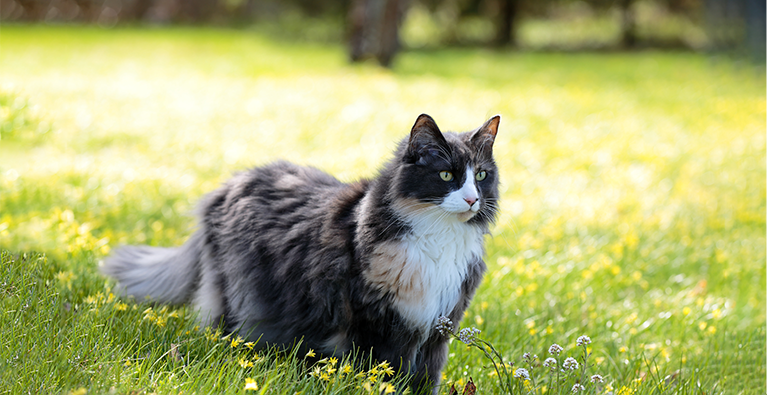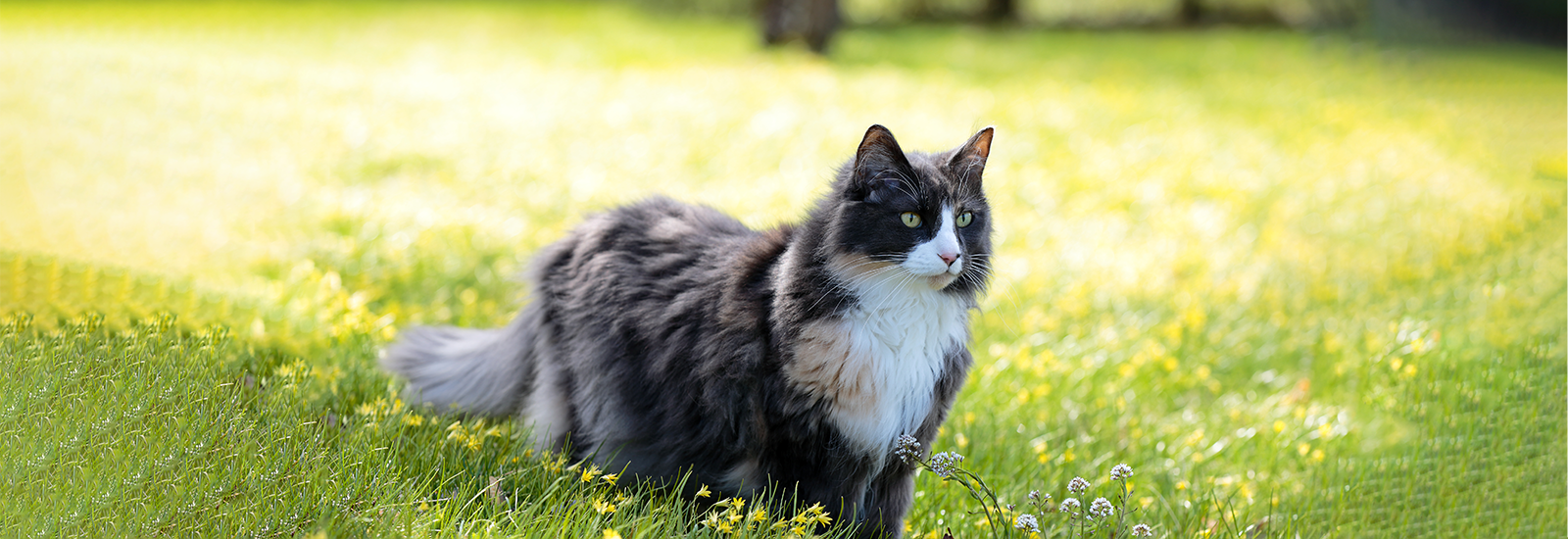Norwegian Forest cat
The Norwegian Forest cat is one of the most impressive breeds of cat. It can reach a length of 130 centimetres. As a result, it is a very self-confident cat, but it is also playful, talkative and affectionate.
Profile of the Norwegian Forest cat
- Size large
- Weight female: approx. 5.5 kg, male: approx. 7.5 kg
- Origin Scandinavia
- Build elongated, strong
- Length of fur medium-long
- Colour of fur all colours
- Grooming medium
- Behaviour talkative, playful
- Character self-confident, calm and balanced
Appearance and character of the Norwegian Forest cat
Measuring up to 130 centimetres in length, the Norwegian Forest cat is one of the world’s largest breeds of cat. Its body is elongated and muscular, enabling it to make enormous leaps. Its hind legs are slightly longer than those at the front and end in large rounded paws. Its bushy tail and the lynx-like tufts of hair on its ears are especially striking. In addition, its lush fur gives it a very impressive appearance.
Officially, it is classed as a semi-long-haired cat, but its outer coat is particularly long. It consists of coarse and shiny guard hairs that provide perfect protection against the elements. Underneath it has a very woolly undercoat. When the Norwegian Forest cat has its full coat in winter, it has extra thick fur on its neck, chest and hind legs. The breed standard allows all colours for the Norwegian Forest cat’s coat and eyes. Only pointed markings are not included.
As is often the case with large breeds of dog, the Norwegian Forest cat seems to be fully aware of its impressive size. Nothing seems to be able to easily upset this breed of cat and it always seems to have everything under control. It is confident, resilient and fearless. It is therefore also ideal as a cat for families who have a hectic everyday life. In any case, it knows how to defend itself and if things get too much it will simply withdraw to a place where it can enjoy some peace and quiet. However, this will rarely last for very long, because a Norwegian Forest cat tends to be inquisitive, playful and talkative. It loves to chat away with other cats or its two-legged friends. This very sociable cat breed also really enjoys a cuddling session.
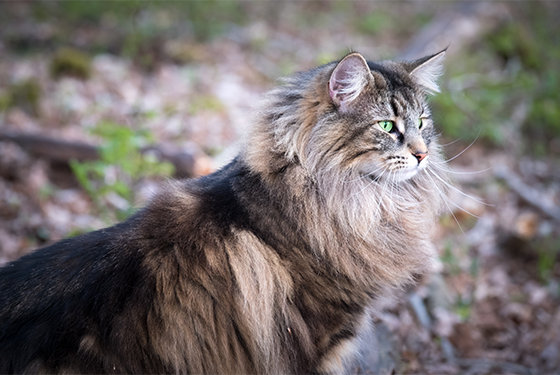
Keeping and caring for a Norwegian Forest cat
Life with a Norwegian Forest cat is not at all problematic. It can easily adapt to new situations, it has no special requirements and tends to be a somewhat reserved housemate. It can, however, sometimes be quite temperamental and bursting with energy. This is when it becomes clear whether your cat tree will stand up to its demands. If you have two adult cats chasing each other, the tree should not only be stable but also firmly secured. Cat trees that reach up to the ceiling and can be fixed at the top are ideal. Your Norwegian Forest cat will also love to have cuddly caves, alternative places to lie down and plenty of toys. Although it is not one of the breeds of cat that wants to play all the time, it is still fond of doing so. Despite its size, it is very quick and agile.
This cat breed does not necessarily need to go outdoors, however it will certainly have no objections to doing so. Perhaps you can provide your pet with a cat-proof balcony or garden. If it has enough variety in its life, the Norwegian Forest cat will have no problem with being kept indoors. Another cat can be a great help here. Life is simply more fun when there are two of you. And their two-legged friends do not have to worry that this will mean they will no longer be able to enjoy cuddling sessions.
When it comes to grooming a Norwegian Forest cat, you should be aware that it has a very thick coat, especially in winter. To avoid any tangles, it should be combed thoroughly around twice a week. As soon as your cat starts to moult, daily combing is recommended because it will lose an enormous amount of fur. If it swallows too much, there is the risk of gastritis. You should therefore provide your pet with plenty of support during the moulting period.
Nutrition
Whether it’s a kitten, an adult cat or a senior – the food for a Norwegian Forest cat should always be of high quality and tailored to its age. Cats are carnivores by nature, so cat food should always contain a high proportion of meaty ingredients. Sugar, flavour enhancers and artificial colourings and preservatives do not belong in the food.
animonda has the ideal food for every stage of your cat’s life. You can choose between kitten, adult and senior cat food. The products are specially formulated to meet the specific nutritional requirements of the different life stages of cats. This provides the best foundation for your pet to enjoy a long and healthy life
Health of the Norwegian Forest cat
Norwegian Forest cats have a life expectancy of around 15 years. This is a good average, which shows that this is a healthy, robust breed. It does not, however, rule out the possibility of hereditary diseases. In order to avoid these as far as possible, responsible breeders always have their cats tested by a vet. One of these diseases is hypertrophic cardiomyopathy (HCM). This is a disorder of the heart muscle that causes a progressive reduction in size of the heart chamber. This can lead to the cat having difficulty breathing.
The hereditary glycogen storage disease (GSD) is also known to occur on rare occasions in this breed. This can result in kittens being born dead or dying a short time later. Problems can also occur in connection with a white coat colour. Under no circumstances should two white Norwegian Forest cats be mated with each other, because this increases the risk of their offspring being born deaf.
History and breeding
Even though the name appears to clearly indicate a natural Nordic breed, this is still a matter of debate today. It cannot be ruled out that Vikings brought these long-haired cats home with them from the Orient. It is also possible that they were cross-bred with Angora and Persian cats at some point. This may have been to solve the problem that when they were occasionally mated with feral domestic short-haired cats, the latter’s genes would frequently prevail with regard to coat length. However, over the centuries, the harsh Scandinavian climate has undoubtedly also contributed to the development of this large, robust breed of cat with its highly weather-resistant coat. It has no trouble withstanding temperatures of minus 10 degrees.
Whether it is a natural breed or not – the Norwegians are very proud of this feline breed and adopted it as their national cat in 1972. This has led to more efforts being put into pure breeding. It was only thanks to this work that in 1997 the Norwegian Forest cat was finally recognised by the European governing body, FIFe. Since then, its popularity has soared and it has become one of the most popular breeds of cat.
You may also like this
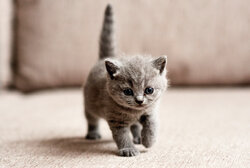
Feeding kitten - nutrition tips
What kittens need for healthy development
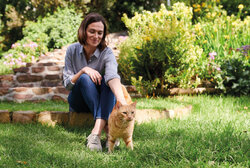
Good cat food
How to recognize good cat foory for your darling

A kitten is moving in
Tips for collection, initial equipment and settling in
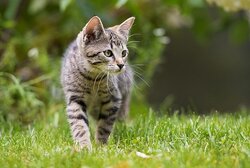
Getting your cat used to being outdoors
How to get your cat used to going outside
